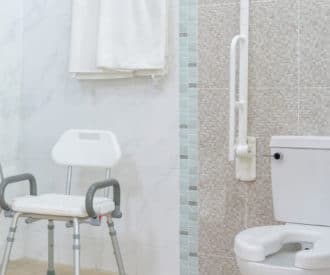
A lot can be done to prevent falls in seniors
Falls may seem like an inevitable part of aging, but there’s actually a lot that can be done to reduce fall risk.
Preventing falls in seniors keeps them healthy and independent for as long as possible and reduces caregiver stress.
Productive conversations about reducing fall risk and simple changes at home can significantly reduce your older adult’s chances of falling.
But those discussions can sometimes be challenging.
To make these sensitive conversations easier, we found a helpful free guide from the National Council on Aging and the National Alliance for Caregiving.
The guide explains why fall prevention is such a serious issue, covers fall prevention basics, and includes a step-by-step conversation guide that helps you take action to prevent falls.
Here, we share an overview of the guide.
Why reducing senior fall risk is so important
Each year, 3 million seniors are treated in emergency rooms each year because of a fall, resulting in over 800,000 hospitalizations for resulting injuries.
For many older adults, a fall can cause serious injuries like hip fractures, broken bones, and head injuries. This significantly worsens mobility, health, independence, and well-being.
Research also shows that after someone’s first fall, caregivers report a significant increase in caregiver burden, fear of falling, and depression.
This conversation guide helps you take action to prevent falls in seniors
We like this free guide because it’s easy to understand and includes helpful checklists.
The information is straightforward and broken up into 3 sections. Here’s what they cover:
Step 1 (page 4): Is it time to talk about fall prevention?
This handy checklist helps you figure out if your older adult is at risk for a fall.
Answer the questions on their behalf to gauge their fall risk. A score of 4 or more points means that the person might be at risk for a serious fall in the future.
Next, answer the questions for yourself to assess your own fall risk — it’s important for you to be safe as well.
Step 2 (page 5): Talk about falls prevention with others
If the checklist in Step 1 indicates that your older adult’s fall risk is high, the next step is to talk with them about it.
The list in Step 2 walks you through how to prepare for a successful conversation, gives suggestions on what to say, and helps set reasonable expectations.
Step 3 (pages 6-7): Develop a falls prevention action plan
In the third step, get 7 tips for creating an action plan to reduce fall risk.
The risks you identified in Step 1 and the conversation notes in Step 2 will help you create the plan.
Additional resources (page 9)
Get additional information like infographics, brochures, tip sheets, videos, and more.
Recommended for you:
- 6 Age-Related Changes That Increase Senior Fall Risk and What to Do About Them
- 3 Easy Balance Exercises Prevent Falls in Seniors
- 10 Medications That Cause Falls: Use with Caution
About the Author

Connie Chow
Connie was a hands-on caregiver for her grandmother for 20 years. (Grandma made it to 101 years old!) She knows how challenging, overwhelming, and all-consuming caring for an older adult can be. She also knows how important support is — especially in the form of practical solutions, valuable resources, and self-care tips.




